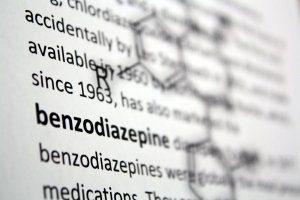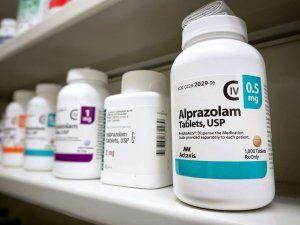
Benzodiazepines
Benzodiazepines – a list of drugs and their effects. What to do in case of poisoning and intoxication? What is the most effective antidote? We will talk about the narcotic effect of benzodiazepines, as well as analyze the mechanism of action of the drugs.
ak is a group of psychotropic drugs that have sedative, sedative, hypnotic and anticonvulsant effects. By acting on GABA receptors, they suppress the excitability of the nervous system and are prescribed for the treatment of epilepsy, panic attacks, relieve anxiety, muscle spasms, and are used to treat insomnia, but when used improperly, benzodiazepines turn into dangerous addictive drugs.

The effect of benzodiazepines
Once in the body, drugs of this type come into contact with GABA receptors, changing the flow of chlorine ions into the cells of the central nervous system, which causes an inhibition of activity. At the same time, each type of medication is designed to affect subclasses of receptors responsible for certain reactions. Thus, by acting on the alpha receptors of benzodiazepines, the drug reduces anxiety, increases drowsiness on others, and suppresses muscle cramps and nervous tics on others.
This group of receptors regulates appetite, eating, and emotional behavior, reduces anxiety, and prevents seizures and tics during temperature changes. If their work is disrupted, a person’s eating behavior changes regardless of the feeling of hunger (the so-called nervous overeating, which provokes the development of obesity, cravings for sweets, develops anxiety, panic attacks, convulsive syndrome, and much more.
Benzodiazepine receptors can be affected by only 2 substances — benzodiazepines and ethyl alcohol. That’s why drinking alcohol can change your appetite and cause you to feel relaxed and anxious. The mechanism of action of benzodiazepines is similar to that of ethanol, causing symptoms such as lethargy, impaired coordination, speech, decreased anxiety, and panic. The intoxicating effect is achieved when the dosage recommended by a specialist is exceeded. Just as with alcohol, people who abuse benzodiazepines and take them without a doctor’s prescription for intoxication feel a sense of euphoria, intoxication, which is dulled by regular use.
Side effects of benzodiazepines
This group of drugs is dangerous for heroin, opioid addicts, barbiturists, people suffering from bronchitis, short-term respiratory arrest during sleep, and depressed patients, especially those with suicidal tendencies. It is strictly not recommended to use benzodiazepines for pregnant women and nursing mothers.
The main symptoms of side effects:
Movement coordination disorders;
Fatigue and weakness;
Drowsiness without being able to sleep;
Impaired concentration and memory;
Tremor, trembling of limbs;
Big weight gain;
Confusion of consciousness;
Nausea, vomiting;
Skin rashes.
In depressive personality disorders, benzodiazepines increase suicidal tendencies. The drugs are not recommended for people suffering from excess weight and decreased attention, memory, asthenia, senile dementia and lowering blood pressure.
Achieving the narcotic effect of benzodiazepines
The effect of euphoria is achieved by exceeding the dosage recommended by the doctor and reducing the frequency of use. The drug tends to accumulate in the tissues, causing a pleasant feeling of relaxation, calmness, intoxication. In addition to sedative and hypnotic effects, benzodiazepine normalizes vascular tone, which makes it possible to normalize blood pressure, especially in the elderly, those who suffer from blood pressure fluctuations, cardiac arrhythmias, however, at a dosage exceeding the norm, this leads to rapid deterioration of the cardiovascular system, deterioration of well-being and possible death.
The first benzodiazepine appeared on the market in 1955, but later the FDA did not recommend using them for long-term use due to the occurrence of dependence and side effects.
Benzodiazepines: medications, list of medications
Such drugs include tranquilizers, anticonvulsants, sedatives, and sleeping pills. They differ in the strength of their effects and the duration of their half-life and elimination from the body. Here’s how the types of drugs containing benzodiazepine differ.:
Short—acting drugs for insomnia remain in the body for 1-12 hours, after which the sleep disorder may resume.;
The average effect is from 12 to 40 hours, causing a long—lasting hypnotic effect. They are used as tranquilizers, against insomnia, aggressiveness, overexcitation.;
Strong and long—acting drugs remain in the body for 40 to 250 hours. They are prescribed in extreme cases, for the treatment of severe patients with epilepsy, convulsive syndrome and other diseases.
Drugs of this group accumulate in the blood plasma and in the adipose tissue of the body. They remain in the urine for 24 hours to several weeks. The duration of benzodiazepines in the body depends on age, metabolic rate, dosage, duration of action and frequency of drug use.
The metabolism of benzodiazepines occurs in the liver, and the active substances themselves are excreted in the urine through the kidneys, so in people with diseases of these organs, the metabolites remain in the body for 100 hours or more, depending on the dosage. They are detected by laboratory blood and urine tests performed within a day after the last dose.
Benzodiazepines are available in the form of capsules, tablets, ampoules for intramuscular, subcutaneous and intravenous use. Here is a list of the main drugs.

Long-acting anticonvulsant medications:
Diazepam;
Lorazepam;
Klobazam;
Gidazepam;
Clonazipam;
Midazolam;
Chlorazapate and their analogues.
These drugs can only be taken according to a specialist’s prescription and strictly in the dosage indicated by the doctor, uncontrolled intake of these drugs can lead to severe intoxication, up to a fatal outcome. This group of drugs has the strongest and longest-lasting effect compared to other analogues of the group. The metabolites can remain in the body for up to 1-2 weeks.
Tranquilizers and benzodiazepines with anxiolytic effects that reduce anxiety include the following medications:
Phenazepam;
Bromazepam;
Chlordiazepoxide;
Alprazolan;
Medazipam;
Oxalepam and their analogues.
The above drugs should also be used only according to a doctor’s prescription and strictly in the specified dosage. Exceeding the dosage can lead to intoxication and the development of dependence.
The following fast-acting benzodiazepines have a mild hypnotic effect:
Temazipam;
Lormetrazipam;
Nitrazepam;
Flunitrazipam and their analogues.
The market for such drugs is constantly replenished, including derivatives of benzodiazepines. These include:
Olanzapine;
Egolanza;
Closed;
Azaleptin.
Despite the apparent simplicity of the effects and the availability of sleeping pills, you also need to be careful with them. Side effects of drugs can reduce the quality of life, and uncontrolled intake with excessive dosage contributes to the development of addiction.
Benzodiazepine withdrawal syndrome is manifested by the following symptoms:
Sudden outbursts of aggression, arousal, and mood swings;
Anger, irritation;
The feeling of alienation of one’s own personality;
Bouts of anxiety, anxiety, and panic;
Nightmarish dreams, daytime illusions, confused consciousness;
A combination of lethargy, delayed reaction with overexcitation;
Depression, depression, increasing indifference.
Physiological symptoms of withdrawal:
Severe sweating;
Fingertip trembling;
Increase in body temperature;
Slowing of heart rate and respiration;
Pallor of the skin;
Pupil dilation.
The abuse of tranquilizers, anticonvulsants and hypnotics provokes an exacerbation and the appearance of mental disorders, emotional instability, which leads to unpredictable reactions of the body. Some patients develop psychoses, delusions, and hallucinations accompanied by a strong sense of fear.
